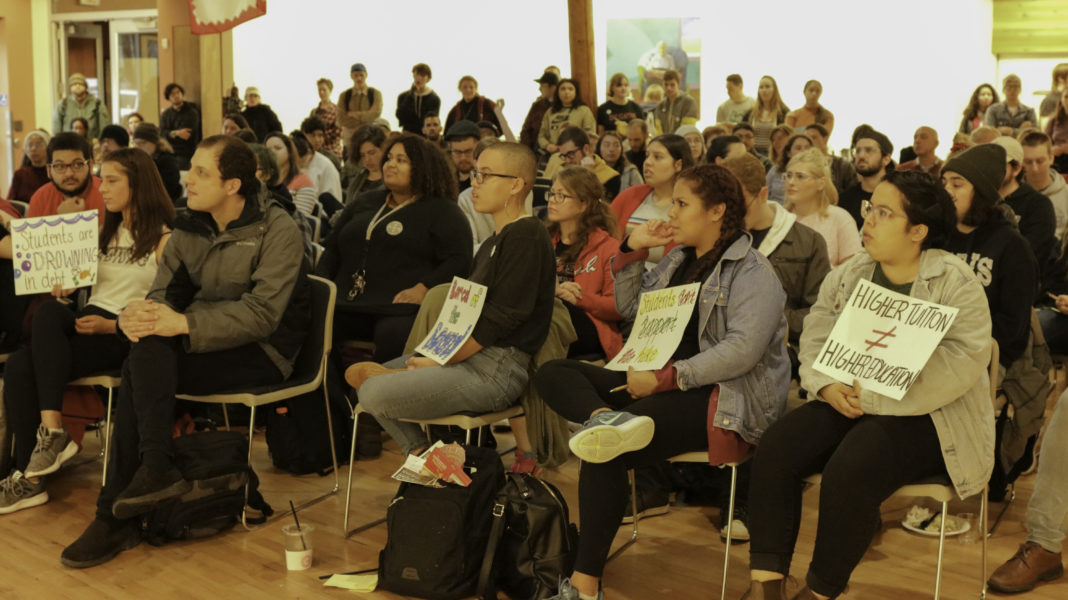If the Portland State Board of Trustees votes to increase tuition at its next meeting Thursday, April 12, Associated Students of Portland State University will strike.
“We’re furious because of the track we’re on,” said ASPSU President Brent Finkbeiner. “We’re facing [tuition] increases every year.”
The Board of Trustees will vote on increases totaling 4.98 percent for full-time resident undergraduate students, 3.64 percent for non-resident undergraduates, 3.24 percent for resident graduates and 4.13 percent for non-resident graduates for the 2018–2019 academic year. Current full-time resident tuition at PSU is $8,783, so a 4.98 percent increase would amount to $437 extra next year.
Reynolds said PSU projects a budget shortfall of 3.4 percent next fiscal year, or $33 million if state support does not increase. The deficit is likely to be filled by budget cuts in combination with the proposed tuition hike.
After last year’s tuition increase, Reynolds and other administrators assured students the administration would try to keep its next biennium increase at or below 5 percent. As the next academic year will be the second of the 2017–2019 biennium, this falls in line with a 6-year budget forecast presented at the April 11, 2017, Board meeting. This projection assumes a 5 percent tuition increase across the board in the second year of each biennium until 2023, but a 9 percent increase to resident full-time tuition in the first year of each biennium. This means that if the university follows its projection, students might see another 9 percent increase proposed in spring 2019.
When the Board finally settled on the 5.45 percent increase to last year’s tuition at a special meeting in July 2017, no mention of this budget projection was made. Finkbeiner said if the university plans to stick to this projection, he thinks that could mean students will see tuition increase by almost 20 percent over the next three years.
“I’m a business major,” Finkbeiner said, “and to appeal to those business elements I would say that an increase to a product or service of almost 20 percent over a three year time span with a projection to [increase] even more is totally irresponsible without raising the quality of that service by a commensurate amount. That’s the path we’re on and that’s why I stand completely opposed to any tuition increase.”
He added, “There has been no full admission [to] how much tuition is going to increase over the next coming years because the percentage is so ugly that no one wants to say it.”
When asked whether students should expect increases as projected over the next several years, Reynolds said he could not predict the increase without knowing how much the state will contribute. He explained the state would need to provide all seven Oregon public universities with a total of about $130 million in order to keep tuition percentage increases for the 2019–2020 academic year from approaching double digits.
Last spring, the Board passed a nine percent tuition increase, which Oregon’s Higher Education Coordinating Commission quickly rejected. After former PSU President Wim Wiewel announced the university would have to cut services by an additional $5 million, Oregon Governor Kate Brown was able to secure more funding for higher education at the last minute, reducing the increase to 5.45 percent. One of Brown’s main goals has been to increase funding for higher education and technical jobs training.
Students confront administration at budget town hall
At ASPSU’s third public tuition forum Thursday, April 5, about 50 students, some holding protest signs, joined members of the administration in the Native American Student Cultural Center for a tense back-and-forth about rising tuition and the administration’s budget concerns.
“Students are drowning in debt,” one sign read. Another said, “Higher tuition [does not equal] higher education.”
Reynolds, Director of Student Financial Aid and Scholarships Mike Johnson, Dean of the School of Business Cliff Allen and Dean of the College of Liberal Arts and Sciences Karen Marrongelle fielded questions from the audience.
One student asked Reynolds, “You’re working within the system. In the last 20 years at PSU, the administration overhead has taken up a larger and larger percentage of the overall budget while less and less has been spent on educators. How can you work toward changing that trend so that it’s more equitable for our students who are suffering, when less money is spent on educators because more classes are taught by low-paid adjuncts and graduate students?”
Reynolds responded by explaining what constitutes administration and how administrative costs are broken down. During ASPSU’s second tuition forum on March 14, Reynolds said increases to Oregon’s Public Employee Retirement System and declining state support for higher education were partly to blame for next year’s projected budget shortfall. Reducing administrative salaries, he explained, would not substantially address the $33 million deficit.
Cost drivers like renovations to Neuberger Hall and the addition of the $51 million Viking Pavilion to the Peter Stott Center were also among the complaints from students. Reynolds was quick to clarify funding for building projects comes in large part from the state, which is otherwise distributed to other schools if PSU doesn’t advocate for a portion of the grants offered.
Despite last year’s tuition increase reduction, $9 million were cut from the budget for academic programs. Swahili and Ancient Greek were two of the programs recently cut this academic year, as well as the Arabic summer program. Marrongelle admitted to making this decision in response to the funding cuts.
Many audience members also aired grievances related to administration salaries, textbook prices, downsizing departments and programs, capital improvements projects and student retention and graduation rates. Many also complained of general constraints in their ability to live while going to school and personal fears of dropping out due to increased tuition costs.
Johnson addressed upcoming changes to student federal aid, explaining that the Federal Pell Grant will increase to $6,095 while the Oregon Opportunity Grant will increase from $2,250 to $3,200 beginning in the 2018–2019 academic year. However, many students voiced they have been excluded from the Oregon Opportunity Grant, which funds recent Oregonian high school graduates now enrolled in college. In response, Johnson expressed regret for the limitations on awarding scholarships.
Preparing for a possible strike
The town hall ended before students who still had questions or concerns were able to speak. ASPSU is encouraging students to voice further concerns at Thursday’s Board meeting, then possibly stage a walk-out if the tuition increase is passed.
Finkbeiner said he understands the financial constraints PSU is under. He called recent increases to PERS benefits a mistake on the part of the state and acknowledged the government’s waning support for higher education.
Additionally, Finkbeiner said he applauded the university’s efforts to work with students on determining tuition increases. Members of the student and faculty bodies joined administration members six times this academic year in Tuition Review Advisory Council meetings to give their recommendations during the tuition setting process.
However, he added, trustees should be doing more.
“I’m mad because [the Board] was presented with only one option by the [administration]; they were presented with a 5 percent increase, and they went for it,” Finkbeiner said. “[It’s] the responsibility of the [Board] to scrutinize the administration. That’s what I’ve been asking Board members to do—is to assert themselves in their role as a governing body.”
If the Board passes the tuition increases on Thursday, ASPSU plans to walk out of the board room and march through campus. Finkbeiner said he is then calling for a one-day strike to make it clear “[administration members] are literally pushing us out of college.”
The Board of Trustees will meet from 8:30 a.m.–12:30 p.m. Thursday, April 12 in the Academic and Student Recreation Center, Suite 515.
Online version updated at 5:08 p.m. on April 11, 2018 to correct next year’s anticipated dollar amount tuition increase.





